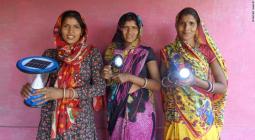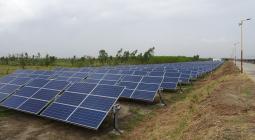5-Fold Increase in Clean Energy Jobs in 5 Years: India

With an average age of 27 and projected 7.5 percent economic growth rate, jobs are a key priority in India. Growth in the renewable energy market is a major opportunity to achieve India’s goals of job expansion and economic growth while meeting climate targets. In fact, solar and wind energy jobs grew an impressive five-fold in the past five years in India.
India’s remarkable job growth is directly linked to the tremendous growth in solar and wind energy. India’s installed renewable energy capacity (solar, wind, small hydro, and biomass power) has more than quadrupled in the last nine years from almost 17 gigawatts (GW) in financial year (FY) 2009-2010 (FY10) to over 80 GW in FY19. Renewables now account for 22% of India’s installed electricity capacity, marching toward India’s goal of 175GW of renewable energy by 2022. Investment in renewables is outpacing fossil fuel projects, with big players, like Tata Power, turning toward renewables.
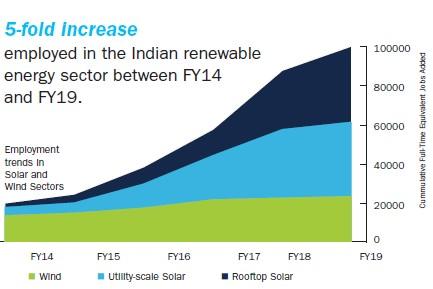
Today, in 2019, nearly 100,000 workers are employed in India’s solar and wind market, up from 19,800 workers in 2014. Powering Jobs with Green Energy, a new report byNRDC and partners Council on Energy, Environment and Water and the Skills Council for Green Jobs, is the latest in a series of analysis focused on the Indian job market.
The largest renewable energy growth occurred in FY18 with over 30,000 workers in utility-scale solar, rooftop solar, and wind energy. Yet, FY19 slowed with only 12,400 workers given the limited renewable energy capacity added that year.
Rooftop solar and other decentralized renewable energy technologies continue to employ far more workers than utility-scale solar and wind energy. Over 38,600 workers were employed for just 3.8 GW of total cumulative installed rooftop solar until FY19, as compared to around 37,900 workers for 26.2 GW of total utility scale solar and over 23,300 workers for 35.6 GW of total cumulative wind energy installed in India until FY19.
To continue the clean energy job expansion, the report includes five key recommendations for policy makers, market leaders, and key stakeholders:
- Strengthen support for decentralized renewable energy projects, such as solar rooftops, since decentralized renewable energy has the maximum job creating potential and the mix of utility-scale renewable energy and distributed energy projects India chooses will be pivotal in employment trends in this sector.
- Expand government programs and market investment to ensure steady renewable energy growth to support clean energy job-creation to achieve India’s clean energy potential of at least 330,000 workers and 1 million short-term and long-term job opportunities in the wind and solar sectors by 2022.
- Support local training centers collaborating with industry, particularly in rural areas, to provide a specialized workforce needed by developers, to expand clean energy jobs across India, and to spur local green entrepreneurs.
- Increase reporting of employment generation from renewable energy companies by encouraging companies to report the number of jobs created at every stage of the value chain and the kind of skills required to ensure market growth and political support over time.
- Promote domestic solar module manufacturing industry to boost employment since meeting the demand for solar modules required for 100 GW of solar capacity domestically, can employ an additional 45,000 workers.
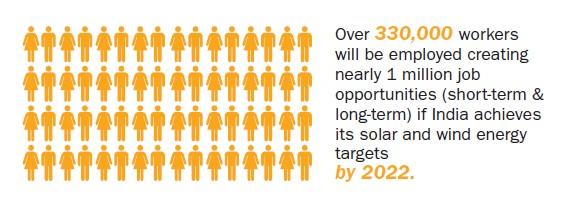
Powering jobs is a main topic of discussion at Energy Horizons in New Delhi hosted by CEEW this week. NRDC and partners will be discussing our report on clean energy jobs with key policy makers and stakeholders. A spate of analysis, including jobs for distributed renewable energy globally, will also be part of the discussions in efforts to expand clean energy jobs worldwide.
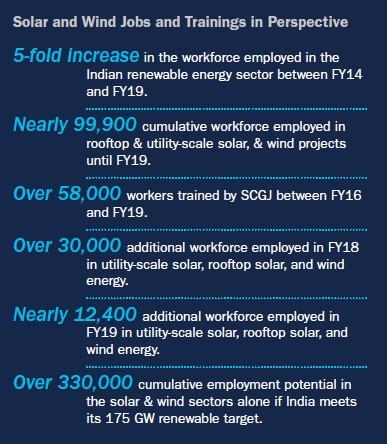
With over 80GW of installed renewable energy in 2022, India is making strong progress in the shift to clean energy. This shift results in real world improvements from more jobs,increased incomes, and reduced-pollution benefits. Yet, much more action is needed to achieve the goal of 175 GW by 2022. Robust policies, training, and financial measures are critical to achieving India’s clean energy targets, improving health, and fighting climate change.
* Co-Authored with Madhura Joshi
14 July 2019
NRDC

